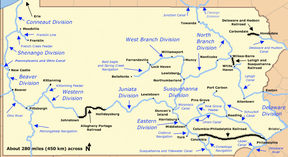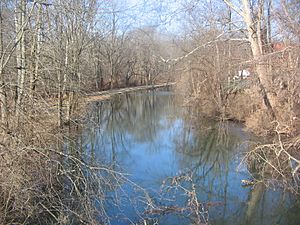Bald Eagle and Spring Creek Navigation facts for kids
Quick facts for kids Bald Eagle and Spring Creek Navigation |
|
|---|---|

Map of historic Pennsylvania canals and connecting railroads
|
|
| Specifications | |
| Status | Abandoned except for historic interest |
| History | |
| Original owner | Bald Eagle and Spring Creek Navigation Company |
| Date of first use | 1837 |
| Date completed | 1848 |
| Date closed | 1865 |
| Geography | |
| Start point | Flemington |
| End point | Bellefonte |
| Connects to | Bald Eagle Cut |
The Bald Eagle and Spring Creek Navigation Company was a canal company in central Pennsylvania. Its main goal was to connect the important iron industry in Bellefonte, Pennsylvania, with the larger Pennsylvania canal system.
The canal opened partly in 1837. The rest of it was finished in 1848. Sadly, a big flood in 1865 destroyed the canal. It was never rebuilt because a new railroad, built that same year, took its place.
Building the Canal
The company was officially started on April 14, 1834. Their plan was to build a canal from Flemington, Pennsylvania, which is near Lock Haven, all the way to Bellefonte. Lock Haven was where the West Branch Canal ended. This was part of Pennsylvania's state-owned canal network.
The canal was designed to follow Bald Eagle Creek southwest. It would go through its valley to Milesburg. Then, it would turn south and follow Spring Creek. This part would go through a water gap in Bald Eagle Mountain to reach Bellefonte. Bellefonte was a big center for making iron.
People in Bellefonte had even pulled a flatboat up Spring Creek in 1800. They did this to show that their town was the "head of navigation." This helped Bellefonte become the county seat (main town) of Centre County instead of Milesburg. Even though boats could use the creek, the canal was needed to move heavy iron products more easily.
Before the Bald Eagle & Spring Creek canal was built, another waterway was made. This was called the Bald Eagle Cut. It was about 4-mile (6.4 km) long. It connected the West Branch Canal through Lock Haven to Bald Eagle Creek. This was where the new canal would begin.
The first part of the Bald Eagle & Spring Creek canal, called the Lower Division, opened in the fall of 1837. It was about 12.5 miles (20.1 km) long and went from Flemington to Howard. Howard was home to an iron furnace.
However, a big economic problem called the Panic of 1837 hit the country. This caused delays in building the rest of the canal for ten years. The next part, from Howard to Milesburg, opened on September 3, 1837. The very last part, which followed Spring Creek into Bellefonte, opened on September 1, 1848. This completed the 12.5 miles (20.1 km) Upper Division. The first canal boat to arrive from Philadelphia was named the Jane Curtin. It carried supplies for a local ironworks.
How the Canal Worked and Why It Closed
The canal quickly became very important for shipping goods. It carried a lot of bituminous coal (a type of coal) and pig iron (raw iron) to other places. It also moved farm products from the local area.
However, the state of Pennsylvania was having trouble paying to keep its large canal system working. The state was already helping to pay for the Bald Eagle & Spring Creek canal. In 1857, this canal, along with others, was sold off. They were given to the Sunbury and Erie Railroad to help them finish building their railway. The railroad then sold them to a new company called the West Branch and Susquehanna Canal.
Around 1857, a new threat appeared: a competing railroad. The Tyrone and Lock Haven Railroad was planned to run through the Bald Eagle Valley, right next to the canal. It would also have a branch to Bellefonte. But this railroad couldn't get enough money to build right away. By 1859, it only finished a small part from Bellefonte to Milesburg.
At first, the railroad actually helped the canal. Docks were built at Milesburg. This allowed coal brought by the railroad to be loaded onto canal boats. But this didn't last. The Pennsylvania Railroad took over the Tyrone & Lock Haven. They renamed it the Bald Eagle Valley Railroad. They finished building the entire line along the Bald Eagle Valley in 1865.
The end of the Bald Eagle and Spring Creek Navigation canal came soon after. From March 15 to 17, 1865, huge floods hit the Susquehanna River area. The floods badly damaged the canal's structures. Since a new railroad was now running right beside it, there was no reason to rebuild the canal.
Today, you can still see some of the stone walls from one of the canal's locks. It's located where the McCoy and Linn ironworks used to be, in the Spring Creek water gap between Bellefonte and Milesburg. This stonework is a reminder of the canal's history.
The remains of Locks #4 and #5 of this canal were added to the National Register of Historic Places in 1979. This means they are recognized as important historical sites.
Places Along the Canal
| Feature | Coordinates | Description |
|---|---|---|
| Flemington | 41°07′21″N 77°28′13″W / 41.12250°N 77.47028°W | A town at the eastern end of the canal. |
| Howard | 41°00′51″N 77°39′29″W / 41.01417°N 77.65806°W | A town near the middle of the canal's path. |
| Bellefonte | 40°54′48″N 77°46′42″W / 40.91333°N 77.77833°W | A town at the western end of the canal. |


